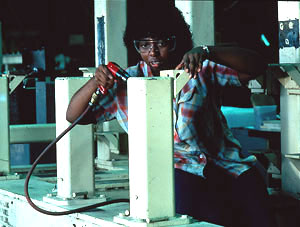
Carlyle Aerostructures
Carlyle Aerostructures
Names for this company have changed through the years, but the early factory site off Murfreesboro Pike in Nashville has not, and the importance of this plant cannot be overstated. Nashville’s Mayor Thomas Cummings (elected 1938) induced Aviation Corporation of California in 1939 to build adjacent to the Berry Field airport a factory that would evolve with the needs and innovations in flight. The $9 million plant, with its projection to employ seven thousand, began by manufacturing personal airplanes and military observation planes. Bought by Vultee Aircraft in 1940, the plant built P-38 Lightning fighters and became the region’s first defense plant. Employing a good number of women as its aircraft workers during wartime, the Vultee Aircraft factory produced its Vultee Vengeance. This plane was used by U.S., British, and British colonial units and saw action in Burma and India, but the dive-bomber never lived up to its expected potential.
After its wartime production, the company became the Nashville Division of Avco Manufacturing Corporation in 1949 and made parts for the Convair B-36 and Lockheed C-130. Since 1960 the Avco Corporation changed names several more times and returned to building parts for war planes. These included parts for Grumman intruder bombers, McDonnell-Douglas F-4 Phantom II fighter jets, C-141 and C-5A cargo planes, and Bell Huey (Vietnam) and Cobra (Vietnam and after) helicopters. At the same time, the construction of wings for Grumman and Lockheed corporate jets continued.
In the last twenty-five years, Avco manufactured parts of the space shuttle, wings for various U.S. and British bombers, European airbuses, as well as rocket nose parts. Its employee rolls reached the seven thousand predicted at the outbreak of World War II. Textron Inc. of Providence, Rhode Island, bought the plant in 1985 and renamed it Textron Aerostructures. The factory sold again in 1996 to the Washington, D.C.-based aerospace investment group called Carlyle, which continues to operate the facility today. As the stakes change, at least part of the pattern has remained the same. Nashville left the depression and believed in the possibilities of growth and forward movement as an urban area and the South as a new industrial area because of the arrival of companies such as Aviation Corporation in the mid-twentieth century.



